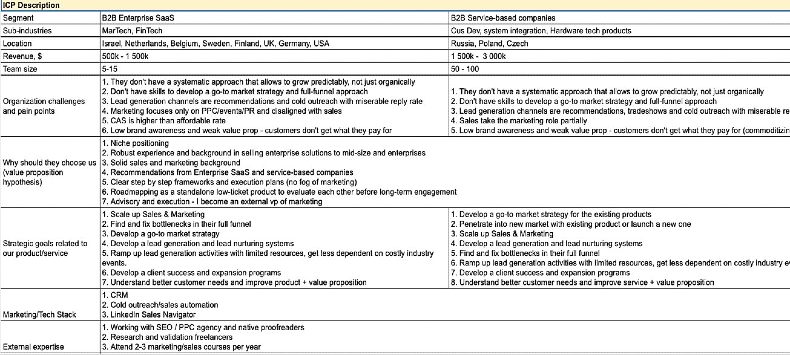"Cold emails, cold calls, and cold messaging are dead."
How many times have you heard that? Especially recently, everybody in the B2B world seems to be talking about demand generation, brand marketing, and storytelling.
But if cold channels are dead, then all marketing channels are. Because every relationship starts "cold."
When you first promote a piece of content to a new audience, it's cold. People don't expect to get content from you. They don't trust you. They are often suspicious (Is he trying to sell me something?). Who likes to "be sold to"?
The real problem is how cold sales outreach works today.
The "sellers" on the other side of your screen are self-focused. All of their behavior demonstrates that they don't care about you; they just want an exchange of money to happen as soon as possible.
Modern cold outreach is similar to what we see in Boiler Room and The Wolf of Wall Street: Scrape the contacts. Set up automation. Spam them all. Pray someone will reply. Rinse and repeat.
Let's be clear: That is not sales outreach; it's spam. And that approach is dead.
To have success with cold outreach, you should...
- Be clear about your ideal customer profile (ICP), including the buying committee structure and how the customer typically buys products like yours.
- Warm-up and engage the entire buying committee.
- Use intent data to seize the moment and reach out at the right time to the right people.
- Master social-selling by connecting and engaging with your target audience on social media, learning more about their needs, and helping them (through consultations or content) by sharing your experience in solving the same challenges.
- Personalize your outreach by explaining how you can help solve your target accounts' specific challenges and help them achieve their strategic goals. Each buying committee member has different needs, goals, and reasons to buy or not to buy your product.
In this article, I'll focus on the first three steps and share practical examples of Steps 4 and 5 throughout those three steps.
1. Ideal Customer Profile (ICP)
An ideal customer profile is a list of attributes that your best customers from a specific market segment have in common.
You have to create separate ICPs for each market segment you are prospecting. Otherwise, you'll fall into a trap of mixing up the data about your customers and ending up with a "one size fits all" solution.
How to Create an ICP in Seven Steps
1. Choose one market segment.
2. Select the Top 10 clients from that segment.
3. Fill in an Ideal Customer Profile template.
4. Define the buying committee members and collect public info about them. The easiest part is collecting demographic data such as sex, age, location, job role, and industry. You can get that data from your customer's LinkedIn profiles.
In addition to that, I also highly recommend collecting data such as...
- Websites your customers are sharing in LinkedIn posts. They show where you can apply for guest posting or cooperation.
- Influencers whose content your customers engage with. They show with whom to start building relationships.
- Communities your customers are a part of. Just as with websites, you can use those communities for cooperation, contribution, and content distribution.
5. Analyze the buying process.
Interview your sales team, asking questions such as...
- What goals was each buying committee member trying to achieve with our product?
- What concerns or objections did you face during the sales process?
- At what stage did the objections appear, and why? How did you handle them?
- What other factors influenced the purchasing decision of each buying committee member?
Then, analyze emails and sales calls to validate the sentiments.
6. Enrich each ICP with in-depth customer interviews.
Here are some sample questions:
- What leads them to buy products like yours?
- What factors influence their purchasing decisions?
- What social media do they use?
- Which industry blogs, websites, or influencers are they following?
- Who else is involved in the negotiation process, or whom do they consult with before buying products like yours?
- If they were to research your product or service, what would they search for?
- What was the problem they were looking to solve before stumbling across your product or service?
7. Define the ICP using all of your data.
Your final result should resemble the following:
Here are a template, checklist, and survey questions you can use to build an ICP profile.
2. Engaging With the Entire Buying Committee
People buy from people they know, like, and trust. When I discuss that inevitable law of marketing with my clients' marketers or SDRs, they always nod their heads in agreement.
But my next question usually makes them numb:
If you know and accept that, why don't you warm up and build a relationship with your target accounts before reaching out to them?
Here are seven ways to do a warm-up. They can skyrocket the reply rate to your outreach campaigns.
1. Connect on LinkedIn with the entire buying committee (or on another channel where its members hang out), engage with content, and start conversations.
A practical example: first, connect with the champion, and give a "value-add," not just a generic connection.
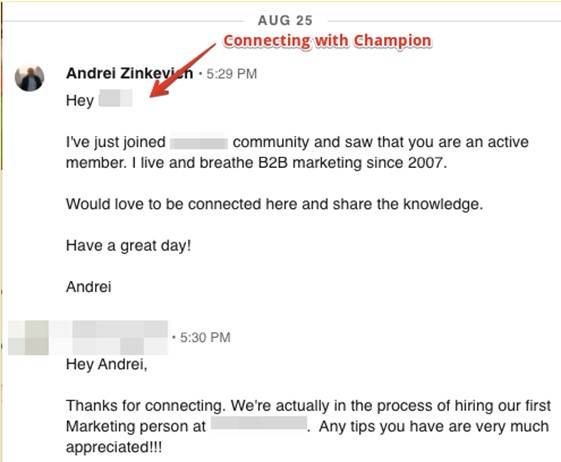
Set up a call to learn more and see how you can help them.
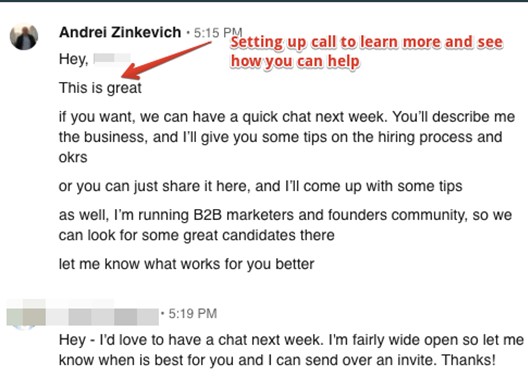
Help deliver more value and build a real relationship, don't just sell them.
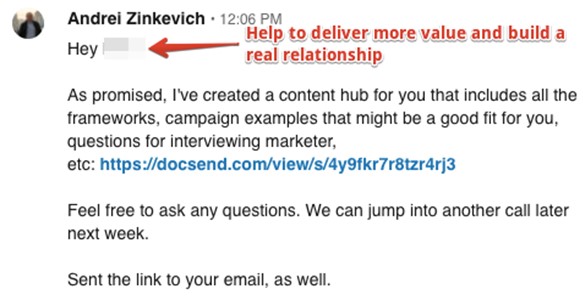
Follow up via email and validate that the relationship is built.
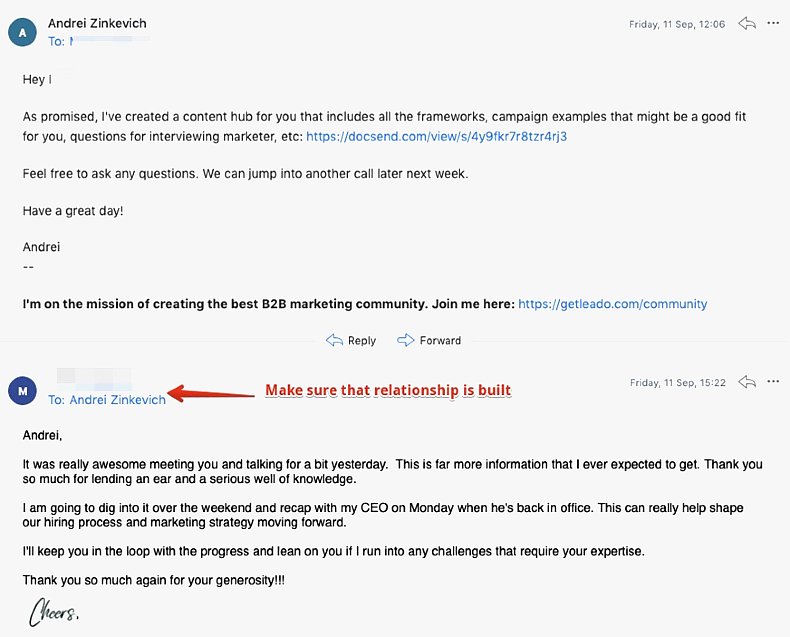
Finally, connect with the decision-maker.
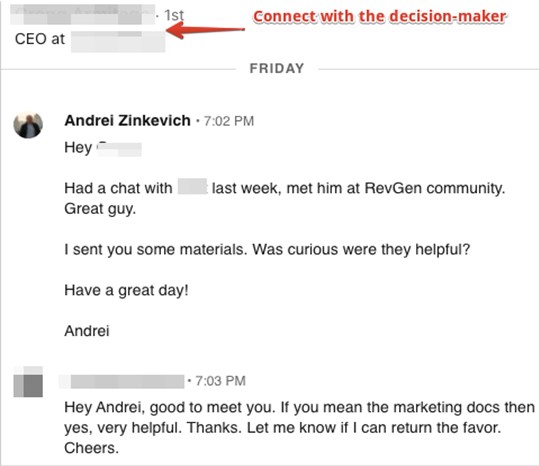
Now the most important people inside your target organization are aware of you and your product. You've built trust and a relationship, and when a need arises you'll be the first company they look to.
Of course, like any relationship, it needs to be nurtured and cultivated as well.
2. Invite your prospects for an interview (podcast, YouTube, or written interview).
This part is a blast. You kill two birds with one stone:
- You deliver value up front by giving PR to your target account.
- You build a relationship and learn more about the goals and needs of your target job role.
Analyze whether there is a match between your product and their needs. Introduce your product, and ask your prospect whether anyone in his or her network might be interested—so you can get priceless intros.
I learned the process from James Carbary, founder and CEO of Sweet Fish Media, a podcast agency for B2B brands.
3. Target your prospect with your best top-of-funnel (TOFU) content (if you have the budget).
4. Retarget them with bottom-of-funnel (BOFU) content (if you have the budget).
5. Post on the channel that features content that matters to your target accounts, and try to involve them in the conversation.
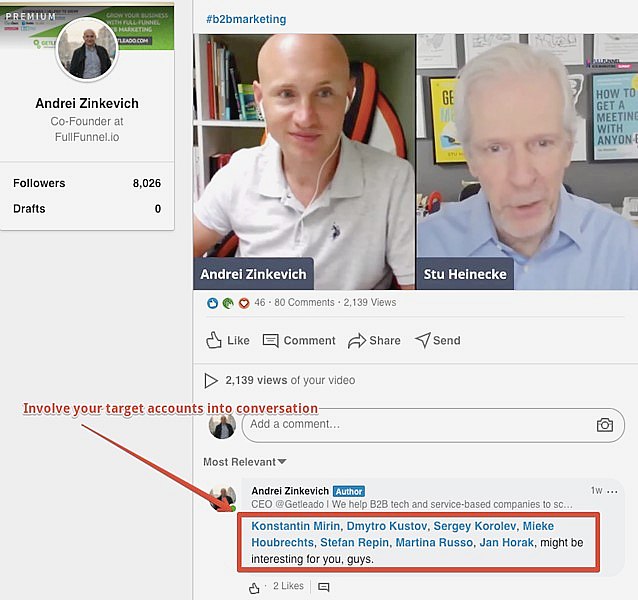
6. Before making a sales outreach, try to run an event where you can introduce (not pitch) your product and make your audience aware of the way you solve their challenges.
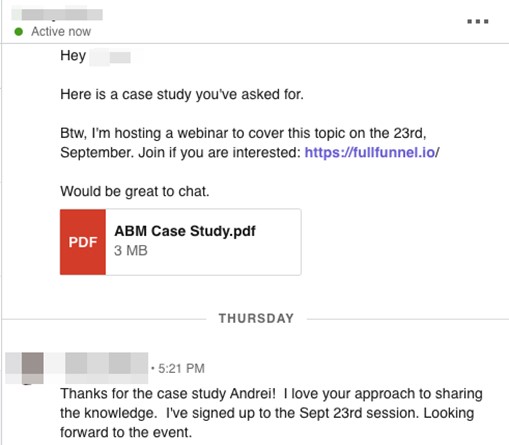
7. Set up outreach triggers.
We'll discuss this in-depth below.
3. Using Intent Data to Reach Out at the Right Moment
Have you ever bought a high-ticket product or service from a cold call or email?
Me neither.
The worst way to do sales outreach is by messaging anyone who could ever possibly be interested in your product. Just because a company fits your ICP doesn't mean it needs your product. Reaching out to them is annoying and generates 0 meetings.
To significantly improve your outreach campaigns' positive reply rate, you need to use intent data and set up outreach triggers.
The three most efficient ways to use intent data are IP identification, manual research, and engagement occasioned by interaction with content:
1. IP identification
IP identification software demonstrates to you what webpages your target accounts have viewed and how much time they spent on your website.
That data helps to identify which stage of the buying journey your prospect is in so that you can personalize your outreach message with the right call to action:
- Share educational resources, such as case studies or articles, for those at the awareness stage, and ask whether that is helpful. Try to establish a relationship, warm up, and learn more about their needs and goals (e.g., Why were you searching for this article or product?).
- Share comparison reports, webinars, market research, or case studies for those considering alternatives.
- Share case studies and suggest your prospect book a free call to learn more for those at decision-making stage. Those are usually the people who visited your product/service page several times and spent some decent time on it.
Here's an example of an outreach trigger you can set up.
If a company visited your product page several times and spent 30 minutes on your website, it is a good signal they are doing research and might be interested in chatting with you.
Below you can see a practical example.
A target account meets your engagement criteria: it spent more than 30 minutes on your site and visited your product page multiple times.
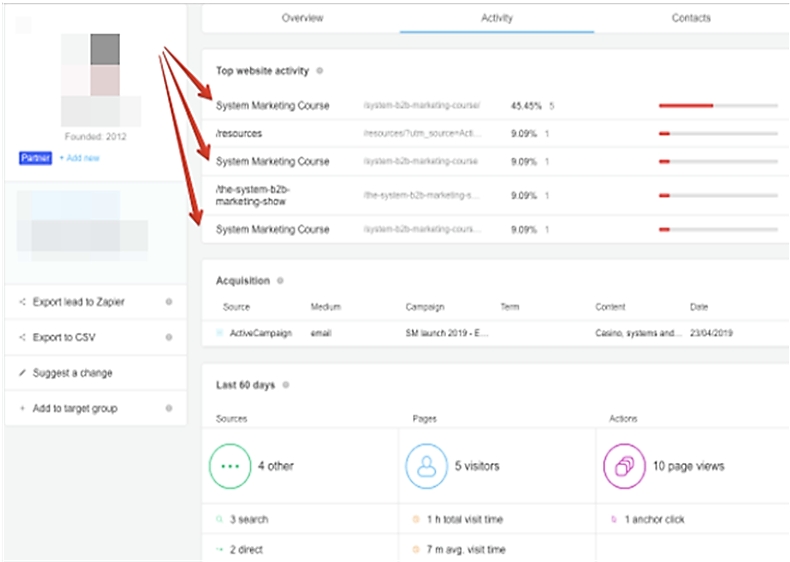
- Find the contacts of your target job role.
- Connect on LinkedIn or another channel and follow-up by email.
You can get access to that intent data by installing IP identification software, such as Albacross.
2. Manual Research
Intent data is not limited to only website visitors. Vendors such as Bombora can help you identify what topics your target accounts are looking for. You can also perform manual research.
To do so, analyze your target account's product road map, check their press releases, or read/listen to their executives' interviews about strategic goals and initiatives.
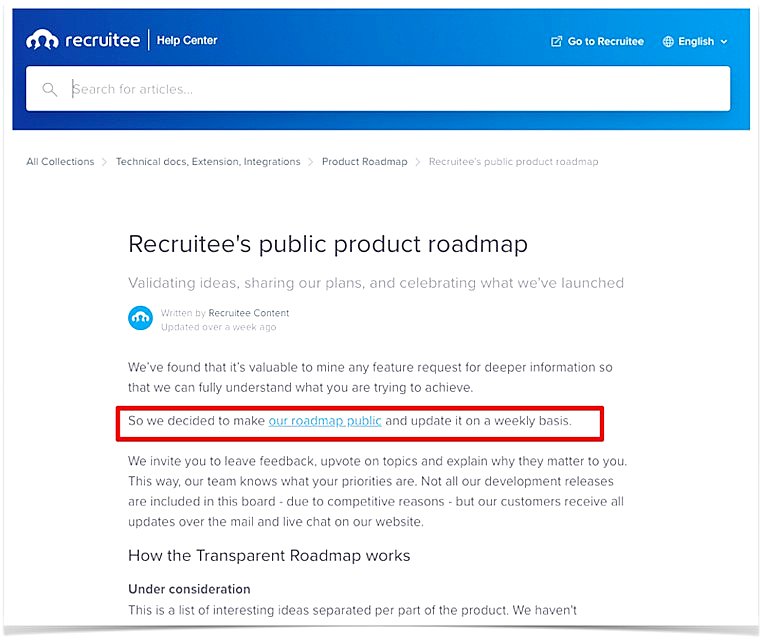
Once you see the match between their goals and your product, you can reach out with a personalized proposal.
3. Engagement With Your Team's or Company's Updates
When the buying committee members of your target accounts engage with your updates on LinkedIn or other social media, it is a perfect trigger to open a conversation, define their challenges and current state, and find a match.
A lot of B2B marketers have been talking about consistently sharing content on LinkedIn, building a network, telling a story, and engaging with influencers' posts, hoping "the leads will come." Unfortunately, most B2B marketing and sales teams are strapped for time and need quick results.
You don't need a big network, hundreds of likes and comments, or thousands of views of your posts to consistently generate high-quality leads. You first create a document and map out all the questions your target accounts will have at different stages of the customer journey.
The next steps are straightforward:
- Connect with the entire buying committee.
- Engage with their updates by commenting and sending private messages.
- Post answers to their questions as posts, tag them in the comments, and share your posts via private messages asking their opinion.
When they engage with your content by answering your message, visiting your profile, or commenting, you have endless opportunities to start the conversation.
Here is a typical process we use with our clients:
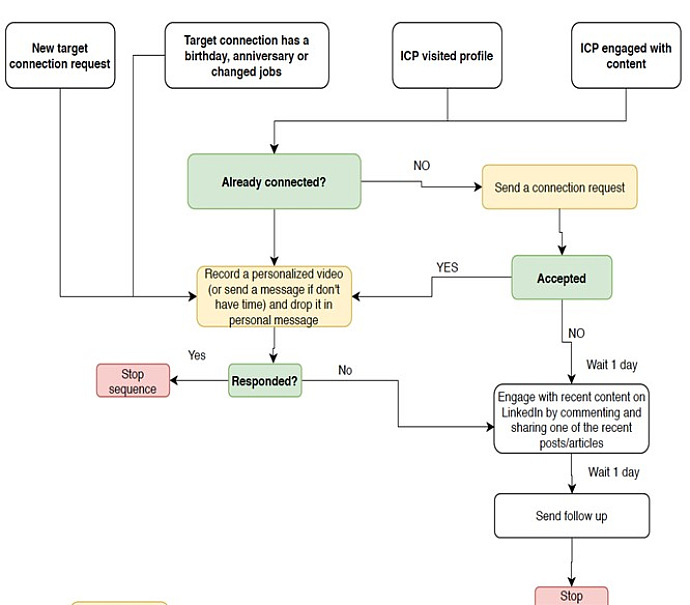
One caveat: don't focus on vanity metrics such as likes, views, or comments. Your key metrics are:
- Number of sales conversations your teams started
- Number of inbound inquiries
I don't get hundreds of likes and comments under my posts, but I consistently get inbound inquiries.
Bottom line: A sales outreach based on intent data shouldn't be a straightforward pitch. Your goal is to open a conversation. Otherwise, your outreach will continue to be just a "numbers game."
* * *
Cold outreach is not dead. What is dead is the way many B2B companies are doing it: spamming or cold-calling anyone who could be interested in their product.
Your goal is to start a conversation and learn more about your target account's needs, and—if there's a match—suggest a call to talk about possible collaboration.
More Resources on Sales Outreach
What B2B Buyers Want: Sales Outreach and Content Preferences
How to Craft Outreach Emails That Convert
The Optimal Sales Cadence: Frequency and Duration Benchmarks
